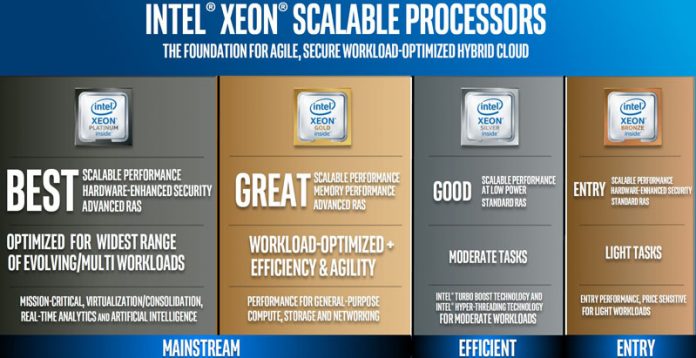The Intel Xeon Scalable Processor Family has four different levels: Platinum, Gold, Silver, and Bronze. We are going to discuss these four different levels in turn. First, we are going to discuss the new naming convention.
Update: 3rd Gen Intel Xeon Scalable
With the 3rd generation Intel Xeon Scalable parts coming to market with Cooper Lake (2020) and Ice Lake (2021) chips, and very different capabilities, Intel has made major updates to the Xeon Bronze (dropped), Silver, Gold, and Platinum lines. Here is a video discussing the updates.
For a written version, you can check out our 3rd Gen Intel Xeon Scalable Ice Lake SKU List and Value Analysis where we discuss the updates as well.
Why the New Naming Convention is a Marketing Abomination
By far, our least favorite part of the Intel Xeon Scalable Processor Family is the new precious metal naming convention. Just to give one an idea, “Intel Xeon Scalable Processor Family Platinum 8180” is around 51 characters to write out, and that is before adding modifiers for additional memory, Omni-Path, and etc. In a world where Twitter tweets encompass 140 characters, Google uses around 156 character meta descriptions. Even an Intel Xeon Platinum 8180 is 24 characters. The outgoing Intel Xeon E5-2699 V4 (21 characters) is long enough. If you are in industry server marketing, or if you are a customer discussing proposals, adding extra characters is going to, industrywide, waste uncountable hours. Shorter names, please!
Bad enough is the naming convention, but there are really five levels, not four. There are two levels of “Gold” processors. We proposed to Intel that the Xeon Gold 51xx series is simply called the “Jade” series. That both gets us back to the basic Marketing 101 of having an odd number of product options to choose from. It also adds a precious material aimed at a target market of the new naming convention while avoiding confusion.
Beyond the confusion of the overly long names of processors that have more levels than even this complex naming convention contains, there is the issue of having to re-educate an entire industry. While as an editorial outlet this is good business for us, we recognize that we have not heard one OEM, one VAR, one ISV one sales person or customer who has not been confused by the new naming convention.
At STH, we generally do not publish rants, so we will end our modest editorial quip on the intensely silly new naming convention and get down to the business of trying to show what the new naming conventions mean.
The Intel Xeon Scalable Processor Family: Target Markets for Platinum, Gold, Silver, and Bronze CPUs
Apologies for the comically long subheading. It is part of the new naming convention. Here is the slide that gives us the “four” levels of the new Intel Xeon Scalable Processor Family:
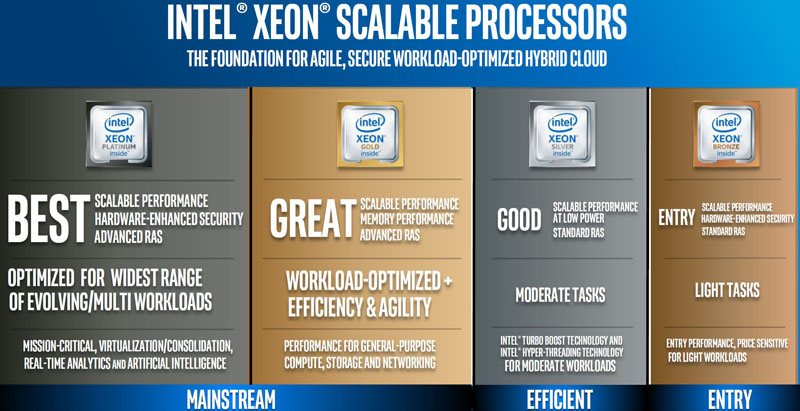
First, we have the top-end Platinum SKUs. These CPUs have almost every feature available to them. This includes the new RAS features, and support for up to eight sockets. This is essentially the tier that we would expect to see as the old Intel Xeon E7 series CPUs.
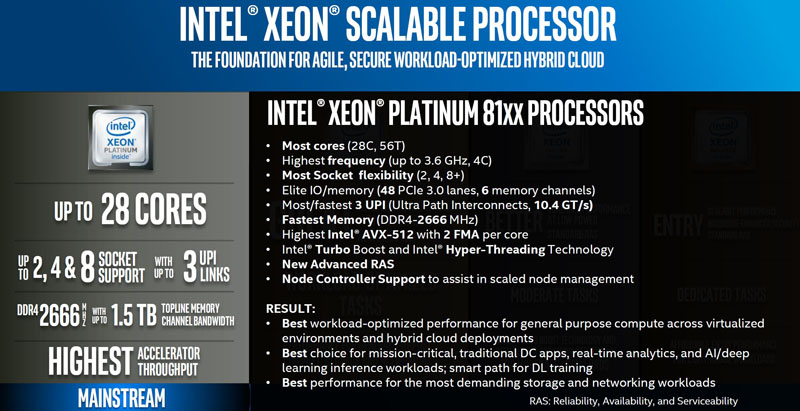
Unlike the outgoing Intel Xeon E7 series, not all Platinum SKUs have higher memory capacity support. Only four of the seven high memory SKUs are Platinum. The Platinum SKUs also have higher TDP ranges (105W to 205W) versus the Gold series (85W to 200W.)
The new TDP range is a major change. Intel Xeon E7 V4 range topped out at 165W. We have heard that next-generation Knight’s Mill / -SP V2 parts may be significantly higher TDP yet again. That was a major reason behind seeing so many liquid cooling solutions at the latest supercomputing and HPC shows. If 205W seems high, we are going up from here, LGA3647 was designed for that.
The Intel Xeon Gold family has two different model lines. The Intel Xeon Gold 6100 and Intel Xeon Gold 5100 series processors.
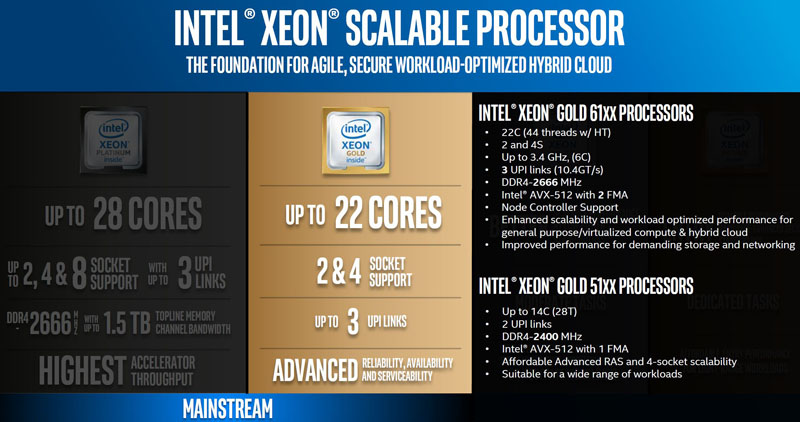
The Intel Xeon Gold 6100 series is limited to up to 4 sockets. It has a full 3 UPI links, supports full DDR4-2666 memory speeds, has both FMA units operational and scales up to 22 cores 44 threads.
The Intel Xeon Gold 5100 series can also run with up to four sockets but can only handle 2 UPI links meaning socket to socket bandwidth will be limited. With only DDR4-2400 support, and up to 14 cores 28 threads, we do not see this as being a mainstream four socket choice and more likely deployed in 1 or 2 socket configurations. There is also only 1 FMA unit so we do not see this as a HPC workhorse. Finally, this is the line that should be called Intel Xeon Jade just to get five levels and avoid confusion.
Below the Intel Xeon Gold line there are the Silver and Bronze levels that only support up to two sockets each, have only 1 FMA unit, have a lower RAS feature set and the lower 9.6GT/s UPI links.
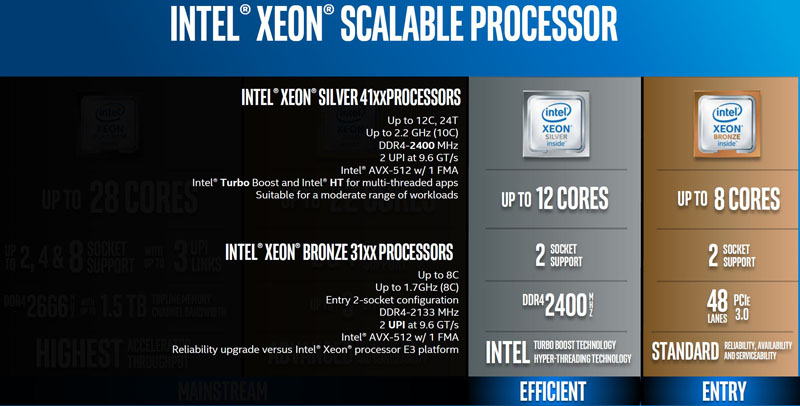
The Intel Xeon Silver 4100 series CPUs are also limited to 12 cores 24 threads and DDR4-2400 memory operation. The Intel Xeon Silver series is targeted at lower power workloads.
Intel Xeon Bronze 3100 series is the successor to the low-end Intel Xeon E5-2603, E5-2609 and similar CPUs. With only 8 cores and a castrated memory speed to DDR4-2133 (2015 level), these are the “light the platform at minimum cost parts.” The Intel Xeon Bronze 3100 series is a significant step up from the old generations.
Here is the basic Intel Xeon Scalable Processor Family product numbering convention decoder package:
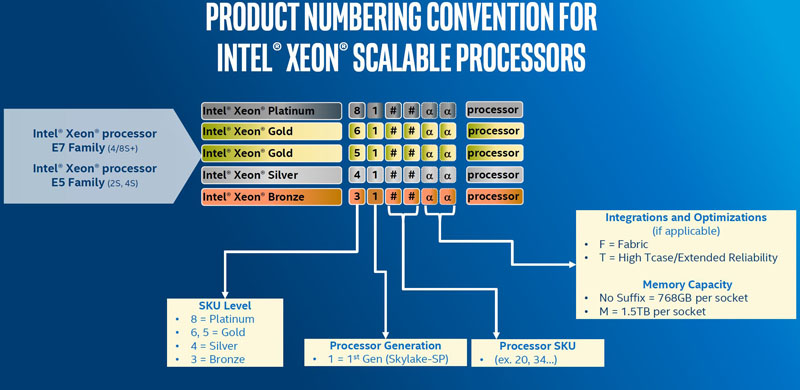
One can clearly see where Intel can introduce CPUs with FPGAs on-package and add this to the letters of a name. There are other features as well such as 3D XPoint DIMMs that can be potentially designated by either family SKU level (e.g. Platinum only) or with letters.
Final Words
Hopefully, this is the last Intel CPU generation with maddening artificial de-tuning of components. These CPUs were spec’d at a time before AMD EPYC. If you are buying in the Intel Xeon Gold 5100 series or the Xeon Silver or Bronze ranges, AMD is going to be worth a serious look. AMD EPYC does not de-tune memory speeds (DDR4-2666 across SKUs.) AMD EPYC has more PCIe lanes. AMD EPYC has more memory capacity across the range (2TB per socket versus 768GB for Intel.)
The Intel Xeon SKU level v. AMD EPYC memory configuration looks completely crazy in high-memory one or two socket configurations. For example, moving from an Intel Xeon Platinum 8180 to 8180M is about $3,000 more just to be able to use an additional 768GB of RAM for 1.5GB total. AMD has parts at a few hundred dollars that can handle more RAM than two Intel Xeon Gold 5100 series parts or even a $10000 Intel Xeon Platinum 8180 SKU. While at the high capacities using 128GB LRDIMMs RAM costs can be $70,000 and up per socket making CPU pricing a small drop in the bucket, the fact that AMD has more RAM slots and DDR4 channels in its platform means that one can use lower cost 32GB DIMMs before moving to 64GB DIMMs which can save a lot.
The bottom line is this. For the Intel Skylake-SP generation, we have what we have in terms of the scalable processor levels. These levels were derived when Intel had no real competition in the x86 server market. With AMD EPYC around, we hope these levels are discarded if not by Cascade Lake, soon thereafter.
We have been using both AMD EPYC and Intel Skylake-SP for some time now. At the bottom-end of the market, Skylake-SP being de-tuned is going to result in cedeing market share to AMD.

